Drugs
Elution patterns of four kinds of basic drugs which have tertiary amine are shown. Under the eluent conditions, large peak tailing and delay of elution are observed for ODS-A and ODS-B except scopolamine. To the contrary, the elution patterns of ODS-C (polymer-coated) and ODP (polymer-based) for procainamide and atropine are far better than those of ODS-A and ODS-B though peak tailing is observed for diphenhydramine. These chromatograms show non-specific adsorption which is usually observed for Asahipak ODP columns and its solution using polymer-based or polymer-coated columns.
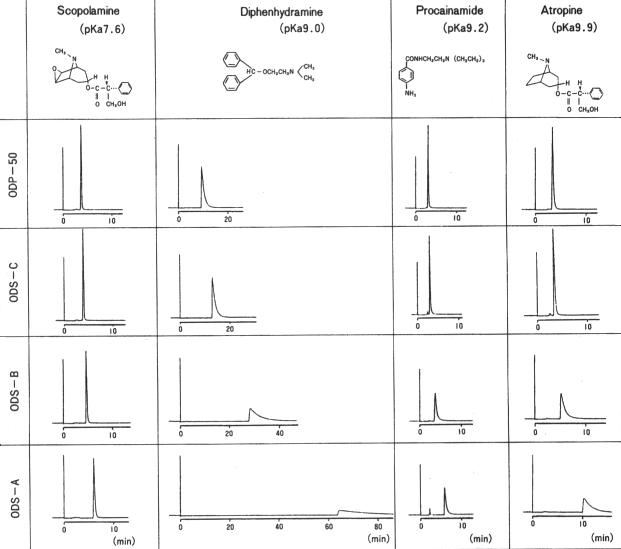
1.0mg/mL Scopolamine hydrochloride, 50micro-L
1.0mg/mLProcainamide hydrochloride, 40micro-L
0.5mg/mLDiphenhydramine hydrochloride, 2micro-L
1.0mg/mLAtropine, 50micro-L
Columns : Shodex Asahipak ODP-50 4D (4.6mmID*150mm), ODS-A, ODS-B, ODS-C (4.6mmID*150mm each) Eluent : 25mM Phosphate buffer(pH7)/CH3CN=60/40 Flow rate : 0.6mL/min Detector : UV(254nm) Column temp. : 30deg-C
Under acidic conditions, it is possible to avoid non-specific adsorption of ODS columns, however retention of basic drugs become too short to realize good separation. This problem is caused by the increase of hydrophilicity due to the dissociation of amines when basic drugs having short amines are analyzed and very popularly observed in the analysis using reversed phase columns. Procainamide and procaine are analyzed under pH7(neutral) and pH3(acidic). Large peak tailing is observed for ODS-A and ODS-B under pH7 and the peak tailing can be solved by decreasing eluent pH to pH3. However, the separation of two peaks is insufficient for all columns including ODP.
For the analysis of basic drugs having short amines, sharp peaks can be obtained by using an alkaline eluent and it is recommended to use Asahipak ODP column for the purpose.
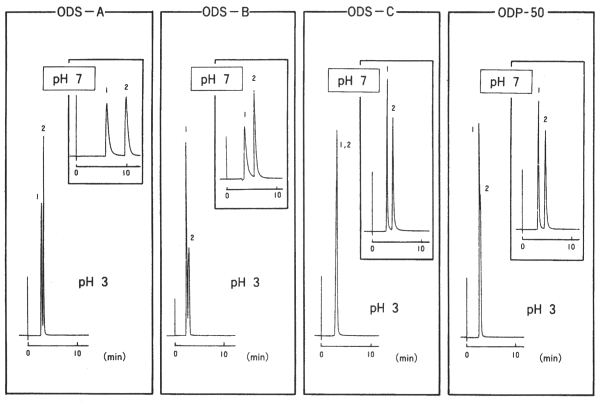
Sample :
1. 0.1mg/mL Procainamide hydrochloride
2. 0.2mg/mL Procaine hydrochloride
Columns : Shodex Asahipak ODP-50 4D (4.6mmID*150mm), ODS-A, ODS-B, ODS-C (4.6mmID*150mm) Eluent : 25mM Phosphate buffer/CH3CN=60/40 Flow rate : 0.6mL/min Detector : UV(254nm) Column temp. : 30deg-C
Effect of ion concentration on elution pattern for the analysis of scopolamine which has tertiary amine and whose pKa is 7.6 is shown. When the ion concentration is lowered, non-specific adsorption is observed for ODS-A and sample is completely adsorbed at the ion concentration lower than 10mM. This tendency is also observed even for ODS-C which is a polymer-coated ODS column and sample is completely adsorbed at 0mM. To the contrary, Asahipak ODP columns are free from the non-specific adsorption problem at any ion concentration level. Then ODP columns are suitable for analysis with the ESI method (LC/MS) in which ionization of sample is often supressed under high-salt concentration.
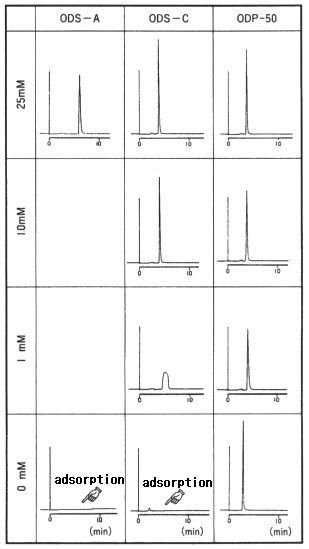
Sample : 1.0mg/mL Scopolamine, 50micro-L
Columns : Shodex Asahipak ODP-50 4D (4.6mmID*150mm), ODS-A, ODS-C (4.6mmID*150mm each) Eluent : Phosphate buffer(pH7)/CH3CN=60/40 Flow rate : 0.6mL/min Detector : UV(254nm) Column temp. : 30deg-C
Antifebriles were analyzed using RSpak DS-613 (a column for reversed phase chromatography).
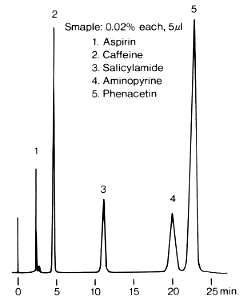
Sample :
1. Aspirin
2. Caffeine
3. Salicylamide
4. Aminopyrine
5. Phenacetin
Column : Shodex RSpak DS-613 (6.0mmID*150mm) Eluent : 1/15M Phosphate buffer(pH7.2)/CH3CN=75/25 Flow rate : 1.0mL/min Detector : UV(254nm) Column temp. : 40deg-C
Five components which are usually contained in the antifebriles were separated using RSpak DM-614 (a column for reversed phase chromatography).
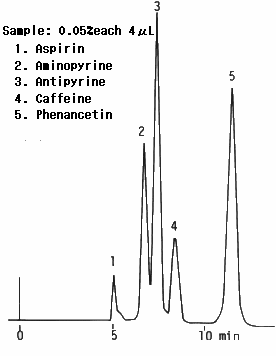
Sample :
1. Aspirin
2. Aminopyrine
3. Antipyrine
4. Caffeine
5. Phenacetin
Column : Shodex RSpak DM-614 (6.0mmID*150mm) Eluent : 0.035M Na2HPO4 + 0.030M KH2PO4 + 35% CH3OH Flow rate : 0.6mL/min Detector : UV(254nm) Column temp. : 27deg-C
Hydrochlorothiazide was analyzed using Asahipak ODP-50 4D (a column for reversed phase chromatography).

Sample : Hydrochlorothiazide
Column : Shodex Asahipak ODP-50 4D (4.6mmID*150mm) Eluent : 25mM Sodium Phosphate buffer(pH7.0)/CH3CN=60/40 Flow rate : 0.6mL/min Detector : UV(254nm) Column temp. : 30deg-C
Anti cancer drugs were analyzed using Asahipak ODP-50 4D (a column for reversed phase chromatography).
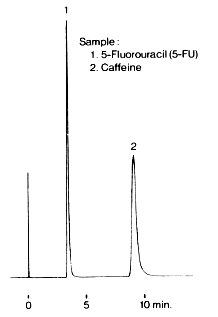
Sample :
1. 5-Fluorouracil, 5-FU
2. Caffeine
Column : Shodex Asahipak ODP-50 4D (4.6mmID*150mm) Eluent : H2O/CH3CN=90/10 Flow rate : 0.6mL/min Detector : UV(254nm) Column temp. : 30deg-C
Drugs were analyzed using Asahipak ODP-50 (a column for reversed phase chromatography).
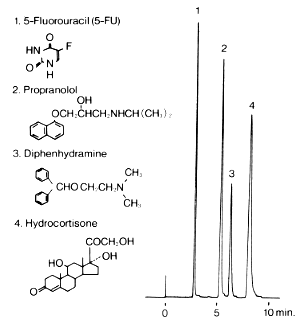
Sample :
1. 5-Fluorouracil (5-FU)
2. Propranolol
3. Diphenhydramine
4. Hydrocortisone
Column : Shodex Asahipak ODP-50 4D (4.6mmID*150mm) Eluent : 25mM Sodium phosphate buffer(pH3.0)/CH3CN=70/30 Flow rate : 0.6mL/min Detector : UV(254nm) Column temp. : 30deg-C
Anti inflammatory drugs were analyzed using Asahipak ODP-50 (a column for reversed phase chromatography).
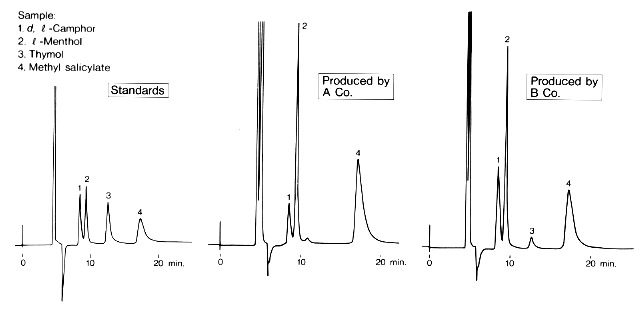
Sample : 1. d,l-Camphor, 2. l-Menthol, 3. Thymol, 4. Methyl salicylate
Column : Shodex Asahipak ODP-50 4E (4.6mmID*250mm) Eluent : 80% CH3OH Flow rate : 0.6mL/min Detector : Shodex RI Column temp. : 30deg-C
Anti inflammatory drugs were analyzed using Asahipak ODP-50 4E (a column for reversed phase chromtography).
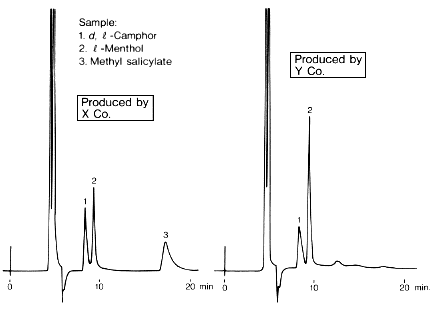
Sample :
1. d,l-Camphor
2. l-Menthol
3. Methyl salicylate
Column : Shodex Asahipak ODP-50 4E (4.6mmID*250mm) Eluent : 80% CH3OH Flow rate : 0.6mL/min Detector : Shodex RI Column temp. : 30deg-C
For the HPLC analysis of basic compounds such as short amines, ion exchange columns or ODS columns with an ion pair reagent are commonly used. However, for the analysis using ODS columns with an ion pair reagent, it is problematic to control the separation because the following two modes contribute to the separation.
1) Mode 1
With this mode, the sample and the ion pair reagent generate an ion pair compound, and at the same time, the sample hydrophobicity increases due to the presence of an alkyl chain coming from the ion pair reagent. Therefore the sample is retained by the column.
R-NH3(+) + ion pair reagent(-) = [R-NH3(+)(-) ion pair reagent]
2) Mode 2
With this mode, the ODS column works as an ion exchange column. The strongly hydrophobic alkyl chain coming from the ion pair reagent is adsorbed by the packing material.
Compared with ODS columns, polymer-based reversed phase ODP2 HP, Asahipak ODP and RSpak DE series columns have the following advantages:
a) Reversed phase analysis of short amines can be performed with an eluent at pH10-11 without using an ion pair reagent.
b) Under alkaline conditions, the peak shapes of short amines are very sharp.
c) ODP and DE columns are stable over a wide pH range from pH2 to pH11.
Scopolamine and atropine were analyzed using Asahipak ODP-50 4D (a column for reversed phase chromatography).
Please refer to Analysis of Short Amines without Using Ion Pair Reagent.

Sample :
1. Scopolamine
2. Atropine
Column : Shodex Asahipak ODP-50 4D (4.6mmID*150mm) Eluent : 50mM Phosphate buffer(pH10)/CH3CN=70/30 Flow rate : 0.6mL/min Detector : UV(210nm) Column temp. : 30deg-C |
: ODS (other manufacturer 4.6mmID*150mm) : 0.1% Sodium 1-pentanesulfonate/CH3CN=60/40 : 1.4mL/min : UV(210nm) : 60deg-C |
Tetracaine was analyzed using Asahipak ODP-50 4D (a column for reversed phase chromatography) with eluents of different pH values.
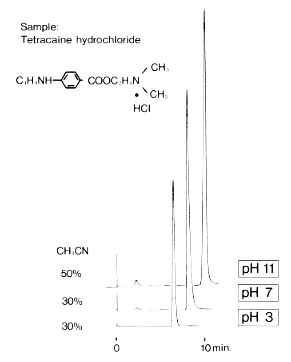
Sample : Tetracaine hydrochloride
Column : Shodex Asahipak ODP-50 4D (4.6mmID*150mm) Eluent : 25mM Phosphate buffer/CH3CN Flow rate : 0.6mL/min Detector : UV(254nm) Column temp. : 30deg-C
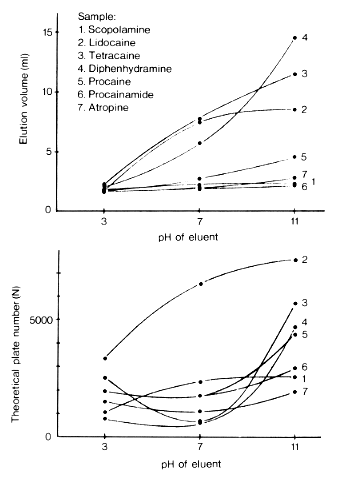
| No. | Sample |
pKa
|
|---|---|---|
| 1 | Scopolamine |
7.6
|
| 2 | Lidocaine |
7.9
|
| 3 | Tetracaine |
8.5
|
| 4 | Diphenhydramine |
9.0
|
| 5 | Procaine |
9.0
|
| 6 | Procainamide |
9.2
|
| 7 | Atropine |
9.9
|
Column : Shodex Asahipak ODP-50 4D (4.6mmID*150mm) Eluent : 25mM Phosphate buffer/CH3CN=60/40 Flow rate : 0.6mL/min Detector : UV(254nm) Column temp. : 30deg-C
Procainamides were analyzed using RSpak DE-613 (a column for reversed phase chromatography) with alkaline eluent.
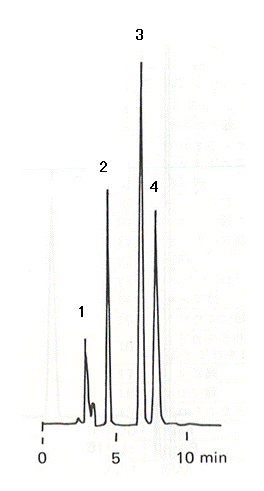
Sample : 8micro-L, 0.1% each
1. Salicylic acid
2. Caffeine
3. N-Acetylprocainamide
4. Procainamide
Column : Shodex RSpak DE-613 (6.0mmID*150mm) Eluent : 50mM Na2HPO4(pH9.7)/CH3CN=70/30 Flow rate : 1.0mL/min Detector : UV(254nm) Column temp. : 60deg-C
Procainamides were analyzed using RSpak DE-413 (a column for reversed phase chromataography) with alkaline eluent.
Please refer to Analysis of Short Amines without Using Ion Pair Reagent.

Sample : 40micro-g/mL each, 10micro-L
1. N-Acetylprocainamide
2. Procainamide
3. N-Propionylprocainamide
Column : Shodex RSpak DE-413 (4.6mmID*150mm) Eluent : 10mM Sodium phosphate buffer(pH11.0)/CH3CN=70/30 Flow rate : 0.8mL/min Detector : UV(254nm) Column temp. : 40deg-C
When using an alkaline eluent with a higher pH than the pKa sample value, basic drug components which have tertiary amino groups can be retained by the column because the amino groups are not dissociated and, in consequence, the hydrophobicity of the drug components decrease. Such analysis conditions can be realized for Asahipak ODP-50 4D because it can be used with alkaline eluent at pH11.
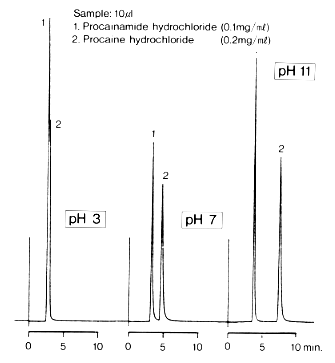
Sample :
1. Procainamide hydrochloride
2. Procaine hydrochloride
Column : Shodex Asahipak ODP-50 4D (4.6mmID*150mm) Eluent : 25mM Phosphate buffer/CH3CN=60/40 Flow rate : 0.6mL/min Detector : UV(254nm) Column temp. : 30deg-C
Methylxantines were analyzed using RSpak DS-613 (a column for reversed phase chromatography).
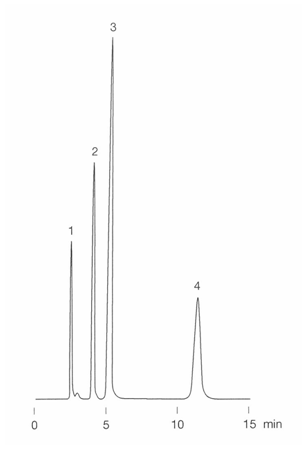
Sample : 0.02% each, 6micro-L
1. Xanthine
2. Theobromine
3. Theophyline
4. Caffeine
Column : Shodex RSpak DS-613 (6.0mmID*150mm) Eluent : H2O/CH3CN=88/12 Flow rate : 1.0mL/min Detector : UV(254nm) Column temp. : 40deg-C
Theobromine, theophylline, caffeine were separated by RSpak DE-413 (4.6mmID x 150mm) and DE-213 (2.0mmID x 150mm). As DE-213 is a semi-micro type column, it can be also used for LC/MS.

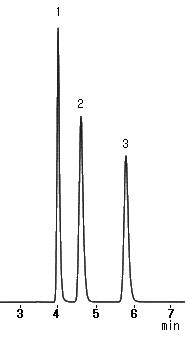
Sample :
1. Theobromine
2. Theophylline
3. Caffeine
(Left) Column : Shodex RSpak DE-413(4.6mmID*150mm) Eluent : H2O/CH3CN=75/25 Flow rate : 0.5mL/min Detector : UV(254nm) Column temp. : 30deg-C |
(Right) : Shodex RSpak DE-213(2.0mmID*150mm) : H2O/CH3CN=75/25 : 0.1mL/min : UV(254nm) : 30deg-C |
When using an alkaline eluent with a higher pH than the pKa sample value, basic drug components which have tertiary amino groups can be retained by the column because the amino groups are not dissociated and, in consequence, the hydrophilicity of the drug components decrease. Such analysis conditions can be realized for Asahipak ODP-50 columns because they can be used at pH11.
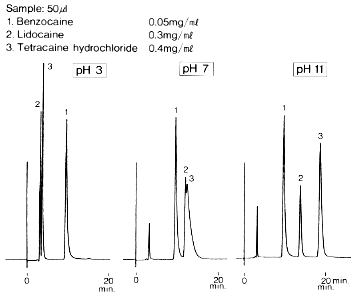

Sample : 1. Benzocaine, 2. Lidocaine, 3. Tetracaine hydrochloride
Column : Shodex Asahipak ODP-50 4D (4.6mmID*150mm) Eluent : 25mM Phosphate buffer/CH3CN=60/40 Flow rate : 0.6mL/min Detector : UV(254nm) Column temp. : 30deg-C
Local anesthetics were analyzed using RSpak DE-413 (a column for reversed phase chromataography) with alkaline eluent.
Please refer to Analysis of Short Amines without Using Ion Pair Reagent.
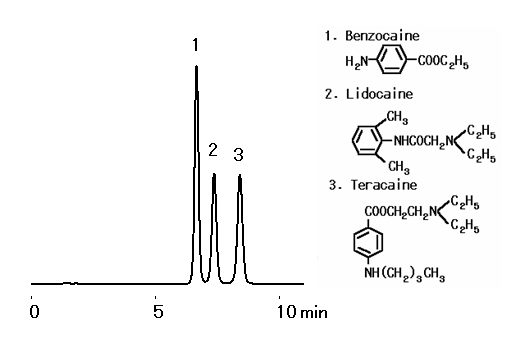

Sample : 10micro-L
1. Benzocaine 20micro-g/mL
2. Lidocaine 100micro-g/mL
3. Tetracaine100micro-g/mL
Column : Shodex RSpak DE-413 (4.6mmID*150mm) Eluent : 20mM Sodium phosphate buffer(pH9.0)/CH3CN=50/50 Flow rate : 0.8mL/min Detector : UV(254nm) Column temp. : 40deg-C
For the analysis of cinchona alkaloids, cinchonine and quinine, which are basic drug components having tertiary amino groups, good separation can be obtained with alkaline eluent at pH9.0 using an Asahipak ODP-50 6D column. The separation at pH7.4 when using ODP or ODS columns is not as good as that obtained at pH9.0 when using an ODP column.
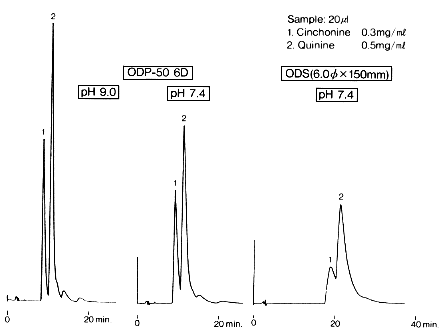
Sample :
1. Cinchonine, 2. Quinine
Column : Shodex Asahipak ODP-50 6D, ODS from other manufacturer (6.0mmID*150mm each) Eluent : 10mM Phosphate buffer/CH3CN/CH3OH=40/20/40 Flow rate : 1.0mL/min Detector : UV(250nm) Column temp. : 30deg-C
Ampicillin was analyzed using Asahipak ODP-50 4D (a column for reversed phase chromatography).
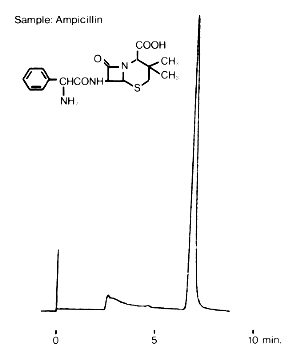
Sample : Ampicillin
Column : Shodex Asahipak ODP-50 4D (4.6mmID*150mm) Eluent : 25mM Sodium phosphate buffer(pH3.0)/CH3CN=90/10 Flow rate : 0.6mL/min Detector : UV(254nm) Column temp. : 30deg-C
Antibiotics were analyzed using RSpak DE-413 (a column for reversed phase chromatography).
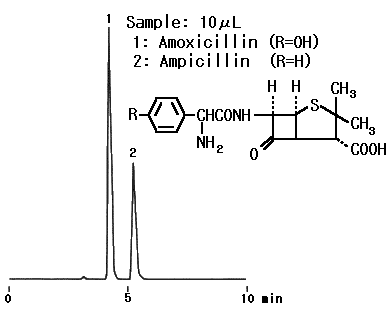
Sample :
1. Amoxicillin
2. Ampicillin
Column : Shodex RSpak DE-413 (4.6mmID*150mm) Eluent : 25mM Sodium phosphate buffer(pH4.5)/CH3CN=50/50 Flow rate : 0.6mL/min Detector : UV(254nm) Column temp. : 40deg-C
Sulfanilamides were analyzed using RSpak DE-413 (a column for reversed phase chromatography).
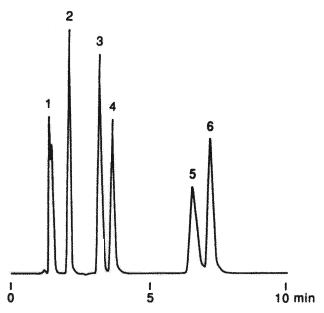
Sample : 20mg/L each, 10micro-L
1. Succinylsulfathiozole
2. Sulfadiazine
3. Sulfamerazine
4. Sulfathiazole
5. Sulfamethazine
6. Sulfanilamide
Column : Shodex RSpak DE-413 (4.6mmID*150mm) Eluent : 25mM Sodium phosphate buffer(pH7.6)/CH3CN/=82/18 Flow rate : 1.0mL/min Detector : UV(254nm) Column temp. : 40deg-C
Barbiturates, which are widely used as hypnotics, have a maximum UV absorbance at 240nm when an alkaline eluent used. This characteristics make it possible to obtain a highly sensitive analysis for barbiturates using Asahipak ODP-50 4D (a column for reversed phase chromatography).
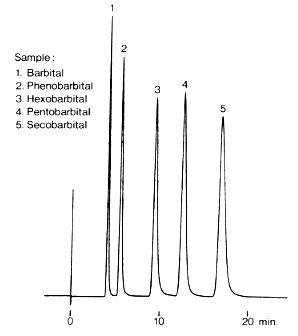
Sample :
1. Barbital
2. Phenobarbital
3. Hexobarbital
4. Pentobarbital
5. Secobarbital
Column : Shodex Asahipak ODP-50 4D (4.6mmID*150mm) Eluent : 50mM Phosphate buffer(pH11.0)/CH3OH=75/25 Flow rate : 0.5mL/min Detector : UV(254nm) Column temp. : 30deg-C
Effect of eluent pH on sensitivity of barbital analysis using Asahipak ODP-50 4D (a column for reversed phase chromatography) is shown.The analysis with alkaline eluent(pH 11.0) gives the best result.

Sample : Barbital
Column : Shodex Asahipak ODP-50 4D (4.6mmID*150mm) Eluent : 25mM Sodium phosphate buffer/CH3CN=60/40 Flow rate : 0.6mL/min Detector : UV(254nm) Column temp. : 30deg-C
Berberine in japanese goldthread were analyzed using Asahipak ODP-50 4D (a column for reversed phase chromatography).
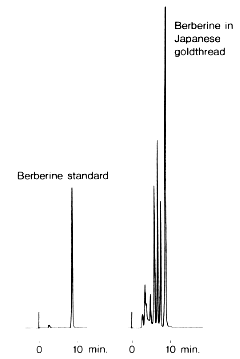
Sample : Berberine in japanese goldthread
Column : Shodex Asahipak ODP-50 4D (4.6mmID*150mm) Eluent : TFA/H2O/CH3CN=0.05/70/30 Flow rate : 0.6mL/min Detector : UV(254nm) Column temp. : 35deg-C
Glycyrrhizin in licorice were analyzed using Asahipak ODP-50 6D (a column for reversed phase chromatography).
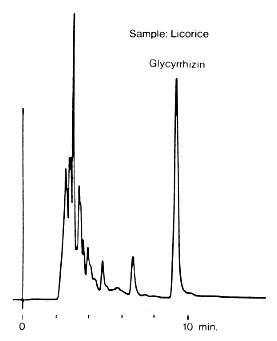
Sample : Glycyrrhizin in licorice
Column : Shodex Asahipak ODP-50 6D (6.0mmID*150mm) Eluent : 0.05% TFA aq./CH3CN=62/38 Flow rate : 1.0mL/min Detector : UV(248nm) Column temp. : 30deg-C
Saikosaponins were analyzed using Asahipak ODP-50 6D (a column for reversed phase chromatography).
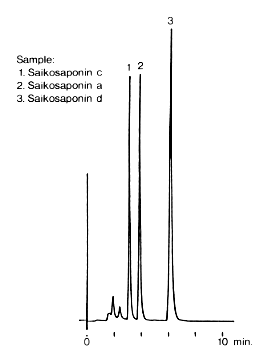
Sample : Saikosaponin
1. Saikosaponin c
2. Saikosaponin a
3. Saikosaponin d
Column : Shodex Asahipak ODP-50 6D (6.0mmID*150mm) Eluent : H2O/CH3CN=50/50 Flow rate : 1.0mL/min Detector : UV(203nm) Column temp. : 30deg-C
Soysaponin in soy bean were analyzed using RSpak DS-613 (a column for reversed phase chromatography).
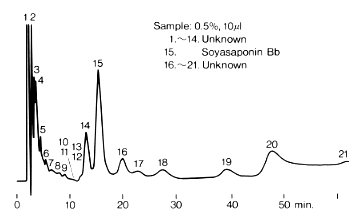
Sample :
1-14. Unknown
15. Soysaponin Bb
16-21. Unknown
Column : Shodex RSpak DS-613 (6.0mmID*150mm) Eluent : CH3COOH/H2O/Isopropanol/CH3CN=0.1/63.4/4.2/32.3 Flow rate : 1.0mL/min Detector : UV(205nm) Column temp. : 25 to 27deg-C
MSpak GF-310 4B and GS-320 4B (columns for rapid analysis of drugs) were used for the analysis of drug components and the results were compared.

Sample : Propranolol
| Retention Times of Drug Components | ||
|---|---|---|
| GF-310 4B | GS-320 4B | |
| Dopamine |
2.2min
|
4.0min
|
| Epinephrine |
2.1min
|
3.7min
|
| Phenobarbital |
6.7min
|
4.4min
|
| Propranolol |
4.3min
|
7.1min
|
Columns : Shodex MSpak GF-310 4B, GS-320 4B (4.6mmID*50mm each) Eluent : 50mM CH3COONH4/CH3CN=70/30 Flow rate : 0.25mL/min Detector : UV(220nm) Column temp. : 30deg-C
Three kinds of Curative drugs to eradicate H.Pyrori were analyzed using MSpak GF-310 2D and JJ-50 2D respectively. These antibitics are used electrochemical detection (ECD).
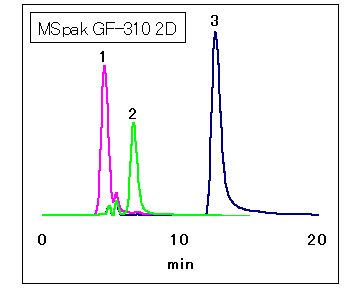
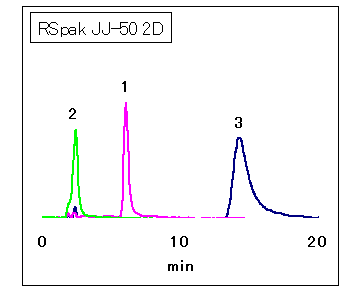
Sample : 10ppm each, 10micror-L
1. Amoxicillin
2. Clarythromycin
3. Lansoprazole
Column : Shodex MSpak GF-310 2D (2.0mmID*150mm) Eluent : 50mM Ammonium acetate buffer(pH7.0)/CH3CN=70/30 Flow rate : 0.1mL/min Detector : ECD (Electrode: Glassy carbon, Applied voltage: +900mV) Column temp. : 45deg-C Column : Shodex RSpak JJ-50 2D (2.0mmID*150mm) Eluent : 50mM Ammonium acetate buffer(pH7.0)/CH3CN=80/20 Flow rate : 0.2mL/min Detector : ECD (Electrode: Glassy carbon, Applied voltage: +900mV) Column temp. : 45deg-C
Enalapril maleate was analyzed with RSpak DS-413. Enalapril maleate is an a vasodilator drug, and it is used as the remedies for cardiac insufficiency.
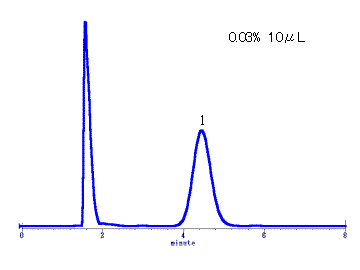
Sample : 1. 0.03% Enalapril maleate, 10micro-L
Column : Shodex RSpak DS-413 (4.6mmID*150mm) Eluent : 20mM Sodium phosphate buffer(pH6.8)/CH3CN=80/20 Flow rate : 1.0mL/min Detector : UV(210nm) Column temp. : 70deg-C
Three kinds of tetracycline derivative antibiotics were analyzed using Asahipak ODP-40 4D (a column for reversed phase chromatography).

Sample : 0.1ppm each, 20micro-L
1. Oxytetracycline
2. Tetracycline
3. Chlortetracycline
Column : Shodex Asahipak ODP-40 4D (4.6mmID*150mm) Eluent : Imidazole buffer/Methanol Detdctor : Fluorescence(Ex.380nm, Em.520nm) Column temp. : 40deg-C
One of short amine, atropine was analyzed using ODP2 HP without addition of ion pair reagent. ODP2 HP is reversed phase column packed polymer beads, and it can be used with alkali eluent. So there is no need to add ion pair reagent.
Please refer Analysis of Short Amines without Using Ion Pair Reagent to know detail about merit of using polymer based column.
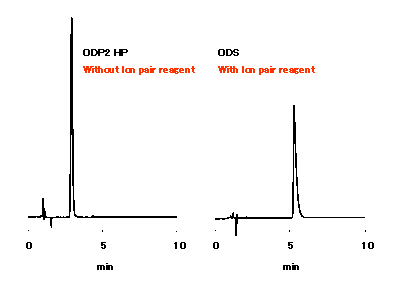
Sample : Atropine (pKa9.9) 300mg/L
Column : Shodex ODP2 HP-4D (4.6mmID*150mm) Eluent : 10mM Sodium phosphate buffer (pH11)/CH3CN=55/45 Flow rate : 1.0mL/min Detector : UV(220nm) Column temp. : 40deg-C Column : ODS from other manufacturer (4.6mmID*150mm) Eluent : 0.1% Sodium 1-pentanesulfonate aq./CH3CN=55/45 Flow rate : 1.0mL/min Detector : UV(220nm) Column temp. : 40deg-C
Ginseng is well known for its various kinds of efficacy and its principal ingredient is saponin, calledas ginsenoside. Approximately 30 kinds of ginsenosides are identified at the moment. Ginsenosides Rb1, Rb2, Rc and Rd were analyzed using Reversed-phase columns RSpak DS-413.
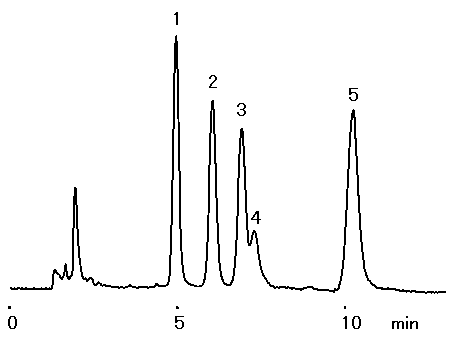
Sample : 100micro-g/mL each, 10micro-L
1. Ginsenoside Rb1
2. Ginsenoside Rc
3. Ginsenoside Rb2
4. Contaminant in Ginsenoside Rb2
5. Ginsenoside Rd
Column : Shodex RSpak DS-413 (4.6mmID*150mm) Eluent : 10mM H3PO4 aq./CH3CN=70/30 Flow rate : 1.0mL/min Detector : UV(210nm) Column temp. : 40deg-C
Alendronic acid, a medicine for osteoporosis, was analyzed by here by Anion IC with the IC NI-424 column.
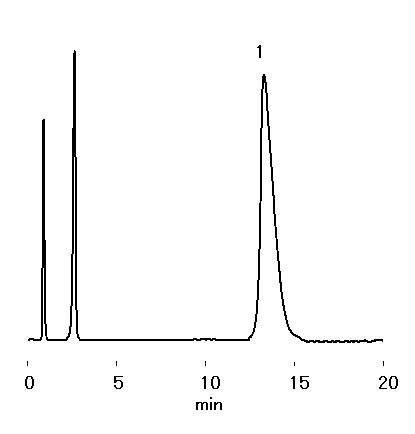
Sample : 20micro-L
1. Alendronic acid 500μg/mL
Column : Shodex IC NI-424 (4.6mmID*100mm) Eluent : 0.5mM H2SO4 aq. Flow rate : 1.0mL/min Detector : Non-suppressed coductivity Column temp. : 40deg-C
The reversed phase Asahipak ODP-40 4E column was used here to analyze simultaneously the macrolide antibiotic Erythromycin and its derivative Azithromycin. The polymer-based ODP-40 4E column is very alkaline-resistant and can therefore be used under alkaline conditions.
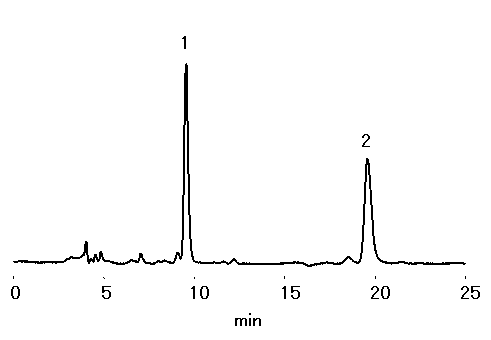
Sample : 0.1% each, 10micro-L
1. Erythromycin
2. Azithromycin
Column : Shodex Asahipak ODP-40 4E (4.6mmID*250mm) Eluent : 40mM Potassium phosphate buffer(pH11.0)/CH3CN=40/60 Flow rate : 0.5mL/min Detector : UV(223nm) Column temp. : 40deg-C
Ribavirin is a purine nucleoside analog and an antiviral drug effective against the Hepatitis C virus as well as many other DNA and RNA-based viruses. It was analyzed here with the column for saccharide analysis SUGAR KS-801.
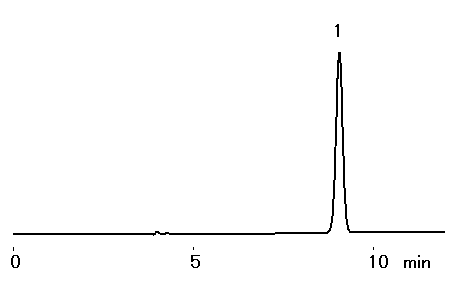
Sample : 10micro-L
1. Ribavirin 0.01%
Column : Shodex SUGAR KS-801 (8.0mmID*300mm) Eluent : H2O Flow rate : 1.0mL/min Detector : UV(207nm) Column temp. : 80deg-C
Voglibose, acarbose, and miglitol are a-glucosidase inhibitors and known as anti-diabetes drugs. Those drugs have sugar structures and thus Asahipak NH2P-50 4E which is often used for sugar analysis, can be used to separate them.
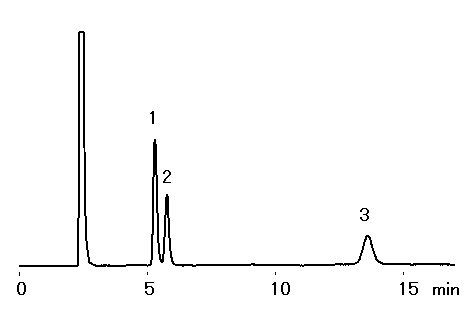
Sample : 0.1% each, 10micro-L
1. Miglitol
2. Voglibose
3. Acarbose
Column : Shodex Asahipak NH2P-50 4E (4.6mmID*250mm) Eluent : CH3CN/H2O=70/30 Flow rate : 1.0mL/min Detector : Shodex RI Column temp. : 30deg-C
Excipients are pharmacologically inactive substances used as carrier for the active pharmaceutical ingredient (API). A significant amount (30-80% solid) of polymeric excipients such as hydroxypropyl methyl cellulose (HPMC), hydroxyl propyl cellulose (HPC), and povidone are generally used. Those excipients have very large molecular (MW) which is not suitable for the commonly used drug QC method by LC-MS. Whereas LC-IR is feasible of characterizing any polymeric excipients in all drug forms.
OHpak SB-806 MQ was used to separate excipients and API based on their sizes. Then size-separated components were detected by IR which provides compositional fingerprinting information. The method is useful in the areas such as drug production quality control, drug deformulation, and/or counterfeit drug testing.
 Sample :
Sample :
Cellulose
Povidone
Hydroxyl propyl cellulose, HPC
Figure 1: Analysis of a test drug sample.
Result shows there were cellulose (Peak A; MW=~485K Da) and two different MW Povidones
(Peak A; MW=~485K Da and Peak B; MW=~49K Da) used as excipients in the tested drug sample.
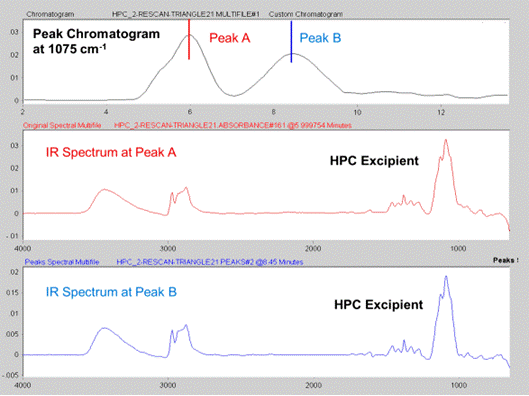
Figure 2: Analysis of HPC sample.
Result shows there were HPC excipient having two different MW distributions (MW information not available).
Column : Shodex OHpak SB-806M HQ (8.0mmID x 300mm) Eluent : 1.5% DMF/H2O Flow rate : 1.0mL/min Detector : DiscovIR-LC™ Column temp. : 40deg-C
Data provided by Dr.Ming Zhou, Spectra Analysis Instruments, Inc. www.spectra-analysis.com


